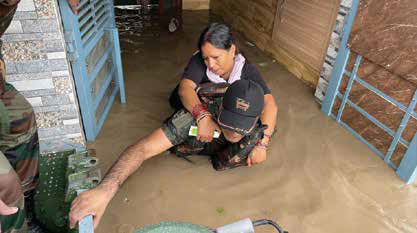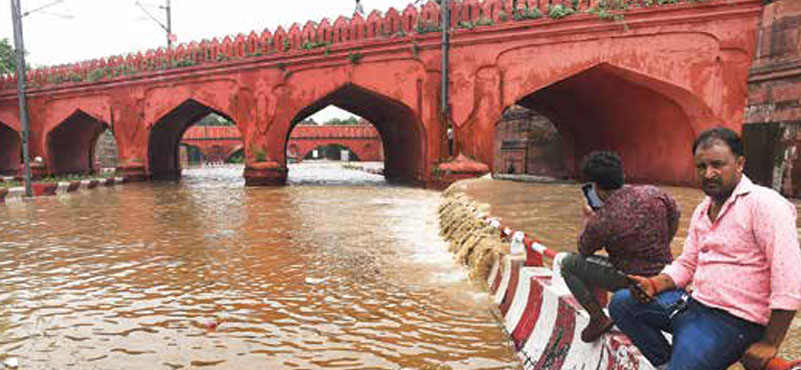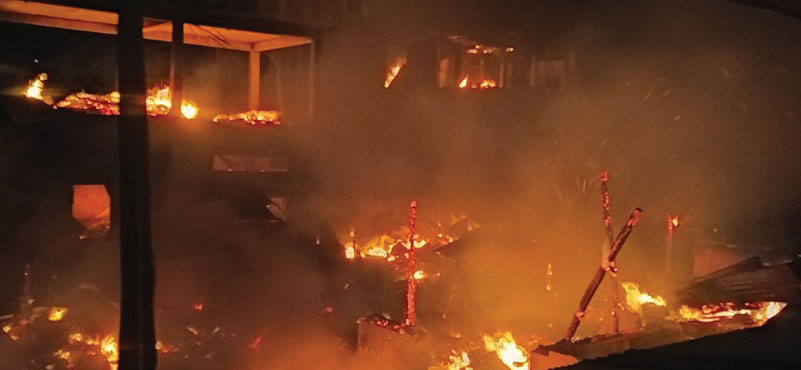This year’s monsoon arrived on time and promise not to leave early. Across the western coast, in the hills and up in the north-east, they have brought disruption to life and property.
It has rained, and rained, and rained. Like not never before, but unlike in the recent past. But what it has done is to expose many weaknesses in our system that most of knew or suspected, but there was no one to ‘bell the cat’. There have been dissenting voices, but these have been ignored. Let me emphasise, it is not any one single political party that one should blame. It is not that time to say what happened in one regime, what happened in another. It has been a consistent systemic failure, our greed to grab what we can, at the lowest cost, if not for free. It is avarice of another degree, that takes into account many unholy alliances between builders, planners, politicians, and most notably the end users. We are all ready to cut corners, wherever we can!
Let us look back at some recent videos that grabbed the national headlines. There was one of the full house, uprooted at its basic foundation, showing there was none in fact – it just got swept away, full house intact. There were many videos where slight overflow of the rivers showed how houses had been built blatantly on the river bed itself. We also saw how entire hillsides just collapsed, into thin air, so fragile was the depth at which they were set.
Not any of this can be explained and blamed on climate change. This is something different. Yes, there is climate change in the air. Rains and fires are being reported globally, temperatures are soaring in Europe and elsewhere, so are floods. Climate is becoming unpredictable. In fact, these have become somewhat more common sights around the world.
Yes, it is also true that nobody can plan for every extreme weather outburst. There are always limits, in every society. This downpour exceeded all limits, it was truly unprecedented.
Having said that, have we respected any limits to our greed – whether it be Nature, building norms referring to safety both for ourselves and for those around us. We have not! Indeed, we should have. Should we start doing so from now onwards?
So, while we can keep crying hoarse, it is more important to get down to some serious business, for once. Let us make a clean break from the past, no mud slinging in any quarter, no blame games, no casting aspersions. So, what do we do! It is a government call, a call from the government of the day! To say, enough is enough, we must set our house in order. It is a humungous task, not an easy one. So, what can we do, as a society?
Accept that we cannot live in fear of safety. That we have flouted norms, and we need to set right what we have wronged. Let us make an example of say a dozen roads, some into the interiors and some on the national highways, I would say more in the interiors that disrupted life and living. Let us do an audit, conducted by crack teams, hopefully who are above influence and will deliver. What has been built with or without permissions on where no building should have come up, should be demolished. Given a month to vacate or else demolished, just like that, it is time bulldozers did something good, for a change.
There should be another safety audit of what has been built along the slopes of hills. Take the Dharampur-Garkhal road in Kasauli, the last few years have witnessed so much construction, one has no idea of what the sanctions were, with what kind of engineering, etc. These should be signalled out by an independent audit; those that have flouted dealt with severely, and made an example of. Government must act, in unison with the centre, and ensure people live safe lives.
All new constructions, or those yet incomplete, there should be a stop, or ban or both. Until this audit approves them. Decisive and swift action is the need of the hour. Where we have sliced through the slope, we must seek remedial measures, if need be, from international consultants who have faced similar situations. Best is to acknowledge we could have done better, and start doing it.

The capital and NCR under siege!
The problem has been severe in the capital, of another kind, where excess rain waters have entered huge parts, virtually cutting off road and life. Life had come to a standstill, in many parts of the Millenium City, and elsewhere in Greater Noida. Not again for the first time, it is the same areas that have been built recently, without sufficient thought to excessive rain water flows.
“What we need is to is simple create 200 m long and 20-30 m wide water harvesting pits in all low-lying areas. These when created will help in recharging the ground water. As well as help in dewatering the excess rain flow. Once it is done, this would be a win-win situation for everyone. We will have enough ground water to enable us to meet water supply requirements. It will avoid flooding, thereby save precious pavements from being damaged. It will bring a substantial saving in maintenance, plus ensure there is no inconvenience to life”, says Kiran K. Kapila, chairman, ICT and former co-chairman, FICCI National Committee on Infrastructure.
Kapila shared with us that he had made a presentation on this subject to the Delhi government, some eight years ago. It was appreciated but never acted upon. Very clearly, we move from one crisis to another, hoping we will not have to encounter the same one again. It is over, but it continues to haunt us, every few years. The sight of Delhi, around the Yamuna bed, became the favourite of short video makers. There were videos taking you on river cruises showing off sights and sounds of the capital, and where roads exist, they were plying in boats!
Says Avay Shukla in his article in HillPost, “it took Nature just one cataclysmic week in Himachal to reclaim the spaces which Man had been encroaching upon for decades, both in the river valleys and the mountain slopes. Our anthropogenic footprints in these areas have been overwhelming, much more than what Nature can sustain and repair. Different digits of this footprint – illegal and legal mining, building construction on steep slopes and the rivers’ flood plains, hydel projects with their attendant blasting and muck dumping, road construction and widening, deforestation of thousands of trees – all these coalesced in this one week of July and triggered a reaction by the elements which should have been expected.”
All the elements that have gone into our self-destruction are here! All these need to be looked into.
Shukla goes on to say: “The four-lane highway between Parwanoo and Dharampur also no longer exists: after spending Rs.4000 crores and ten years on converting a two lane into a four lane we are now left with the original two-lane highway! The cause here is not a river but a mountain slope, that was widened by cutting vertically into the mountain slopes, sometimes as much as 15 to 20 metres.”
“My most fervent hope and prayer is that we learn from this catastrophe and change our engineering, planning and ambitions – that we do not build again on the river beds, that we stop this four-lane madness, that we stop the blasting, tunnelling and vertical cutting of mountain sides, that we put a moratorium on further hydel projects,” he writes.
ABOUT THE AUTHOR
Navin Berry, Editor, Destination India, over five decades has edited publications like CityScan, India Debates and Travel Trends Today. He is the founder of SATTE, India’s first inbound tourism mart, biggest in Asia.




































